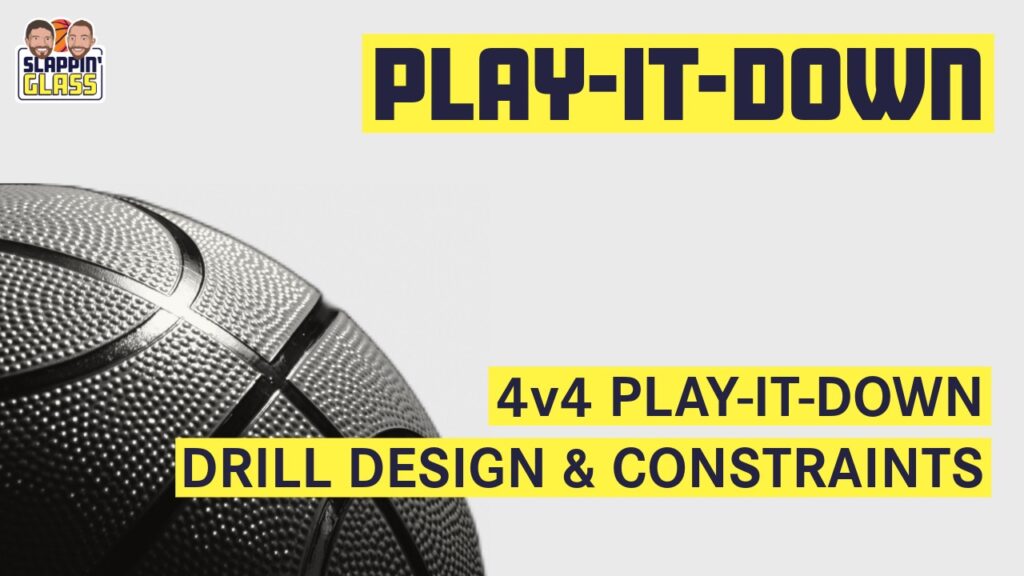Last month on the podcast, Drew Dunlop (Pro Lane founder) sat down with us for a roundtable discussion titled “Practical Thoughts on Ecological Design, Representative Environments, and the CLA”🎙, in which we shared our experiences implementing some of these concepts with our own teams at the Pro and College levels. After that podcast we received a number of inquires about a specific drill we discussed during the conversation, a “4v4 Play-it-Down” series, in which the defense must get a certain number of successful stops to finish the drill while the offense attempts to keep them in, leading to a highly competitive, game-like battle between the two sides…
So, this week, to add both film and depth to that conversation, we went back and pulled some live practice footage from this past year to put together a “voice-over explainer video” of what this drill looks like in action at the college level.
To quickly recap, a “Play-it-Down” refers to one team receiving a certain amount of quick hitting reps, decreasing in the number of players after each rep, within one set. For instance, starting out 4v4 then moving to 3v3, 2v2 and finally 1v1 to end the set. The below drill was used as a way to give representative reps to both the offense and defense, and with the ease of changing certain constraints also a drill to help prepare for opponents later in the season (more on that below).
Drill Design
To begin, here are the parameters for the offense and defense in the drill…
Defensive Goals
- The Defense has two ways they can “finish” the drill and move to offense
- Get “four stops in a row”, or
- Get “3 Sets” of stops, which means stopping the offense 3 out of the 4 reps in the PID series
Once the defense achieves one of these two goals, they are “off” of playing defense and another group moves in.
Offense Goals
- The offense is trying to score at least two out of the four reps to prohibit the defense from getting a “set”
Drill Constraints
The endless variety of constraints a coach can use in this drill give it flexibility to work on both offensive and defensive styles of play. Here are the examples of constraints used in today’s video…
Offense:
- Shot Clock – For the 4v4 rep, the shot clock started at 15 seconds, then moved to 10 seconds for the 3v3 and 2v2 reps, and finished at 5 seconds for the 1v1 rep.
- Note: This Shot Clock constraint was great to force players to find quick solutions along with developing an understanding of how many types of actions could be run with certain time on the clock. This Shot Clock constraint is also where a coach can easily change the “goal” of the drill. For example, we could decrease the time on the shot clock for each “rep” to simulate and emphasize “Late Clock” offense and the types of actions and shot profiles we wanted to fight for.
- Actions – In today’s video example, we gave the offense different “actions” within our offensive concepts to start with before attacking to score. This came in the way of Zooms, PNR’s, Ghosts, DHO’s, etc.
- Note: This is where you can layer in offensive concepts specific to your style of play, or, as we discuss in the video today, have the offense run offensive actions that an upcoming opponent might specialize in to make this more of a “scout” specific drill.
Defense:
- Coverages – During the 4v4 and 3v3 reps of the drill, we would often give the defense specific PNR “coverages” we wanted to work on that day. Again, depending on the defensive emphasis we could also tell the defense they “can’t switch”, “always switch”, “double to post”, etc…
- Note: Again, this is where the drill can be tweaked to prepare for an upcoming opponent, as the defense can be given specific coverages they must play in to simulate how an opponent prefers to play, forcing the offense to find natural solutions to those problems.
The first thing we have grown to appreciate about this drill is the level of pressure and competition it naturally brings out in the group. Each repetition has increasing value for both the offense and defense as they attempt to either avoid moving to defense or, getting a needed final stop on defense to finish the drill. With a certain level of intensity achieved, a game-like environment is created to teach through.
Personal and Group Toughness/Resilience
Something that may not come through on the film, but is well worth mentioning, is the mental toughness and resilience that a drill like this can help build. There are plenty of times where the 1v1 battle is the difference between the defense finishing the drill or needing to start all over if the offense scores. As a coach, this offers some great insight into players that can dig in to get a final stop when they’re tired, as well as the natural leadership that comes out in certain players when a defensive group doesn’t get stops and needs to pull together to move on.
The game is often chaotic, messy and random. This is one of a variety of similar drills we’ve enjoyed implementing because of its ability to provide competitive, and representative game-like reps at the collegiate level.
For much more, and to see live footage of this drill, SG Plus members can view the full breakdown now on SGTV…
